[Adventure]
AX2 Secrets of the Nethercity (2018)
Alexander Macris & Newton Grant
Lvl 3 – 8

The ACKsination is underway. As the ACKs kickstarter (banned by the pretender OSR reddit) grinds its way towards the 300k mark, I have taken it upon myself to dedicate November to the adventures of this most dense, serious, advanced and autistic of OSR retroclones.
While I was preparing for this review, for a period I was overcome by trepidation because it takes quite a while for this adventure to justify itself and even then it does not come without its share of baggage. I envisioned a gradually descending series of ratings, starting with *** for AX1 and ending with some sort of new imaginary negative sub-Cairn rating for AX6. Fortunately things do not look quite so grim. At the end of the day, AX2 is a pretty good dungeon, but you must abstract, and attempt to see the whole, the interlocking parts.
Secrets of the Nethercity takes place in the sewers (take a drink) of the city of Cyfaraun, once the site of a great elven metropolis, destroyed and rebuilt many times, with the new city constructed atop of the ruins of the old one. Enter a realm of catacombs, volcanic caverns, sewers, tombs, cthonic deities, elven mummies, super-science and thick, impenetrable boxed text for a the ultimate simulationist Tomb-crawling experience. Not quite a mega-dungeon, but well over a hundred rooms. Let us dig in!
As I have mentioned to Mr. Macris himself, the biggest problem with ACKs is that it is boring. This might sound flippant but it is true. The books are written in way so that a lot of extraneous detail is covered in a very precise way that is often unlikely to come up in play. Now this robust approach can have advantages when you actually try to run AX2 because presumably the designer cannot always foresee what details will or will not be important so to err on the side of caution means that the GM will always have some handholds in case unforeseen situations come up. In addition, as we have seen in Caverns of Thracia, for many people there is something appealing about exploring a location and gradually discovering, through inferrence, its history as you delve deeper into its substrate. There is substance and thought put into almost everything here, an underlying order of things for the mind to engage with. The downside is that everything feels padded, entries always have one or two sentences too many and a lot of content will concern factors that are peripheral or that may be inferred by the GM. In previous adventures, such gygaxian naturalism was always hinted at, left up to the GM to interpret. By making it explicit, it theoretically makes the text more accessible but this all adds to the page count. Indeed, I suspect a casual reader who picks up AX2 might give up on it 30 pages in, which would be a damn shame, because a lot of interesting material is contained within its 186 page bulk.
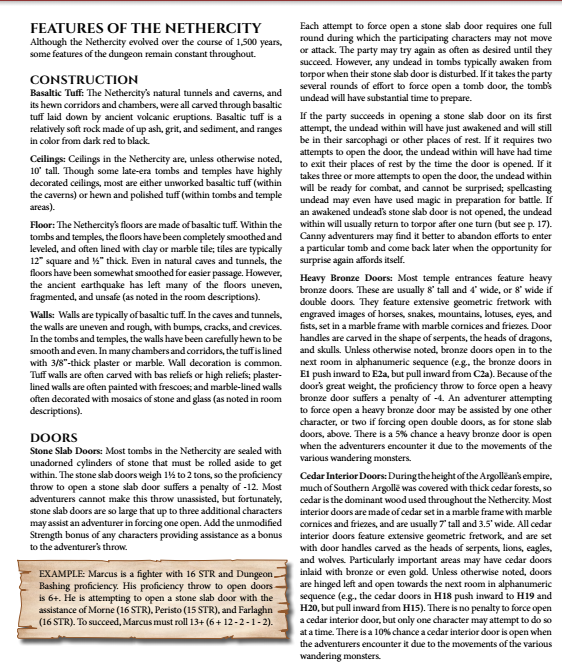
Some good things before we get to the dungeon proper. I like it that Macris provides a d20 treasure table for random grave goods (this is a peripheral detail but its nice to have something to hand in case the PCs ask before they recognize it is unimportant), random reactions for the mummies in case you try to parlay with them as you interrupt their eternal repose (this is very likely to come up), there’s notes on possibly attracting the attention of factions in the (described in a different supplement) overcity, rules for wading through sewage (insert ACKs meme) or setting off pockets of methane with a torch and so on. Extensive Wandering monster tables are provided for four different terrain types, with special notes for the type of monsters that can penetrate sealed off rooms. In a fit of pique, the random encounters are divided across different types of terrain, which CAN be inferred but this is a remarkably subtle process, a rarity for the almost pathologically explicit ACKs. Encounter rate is a forgiving 1 in 6 every 3 turns.
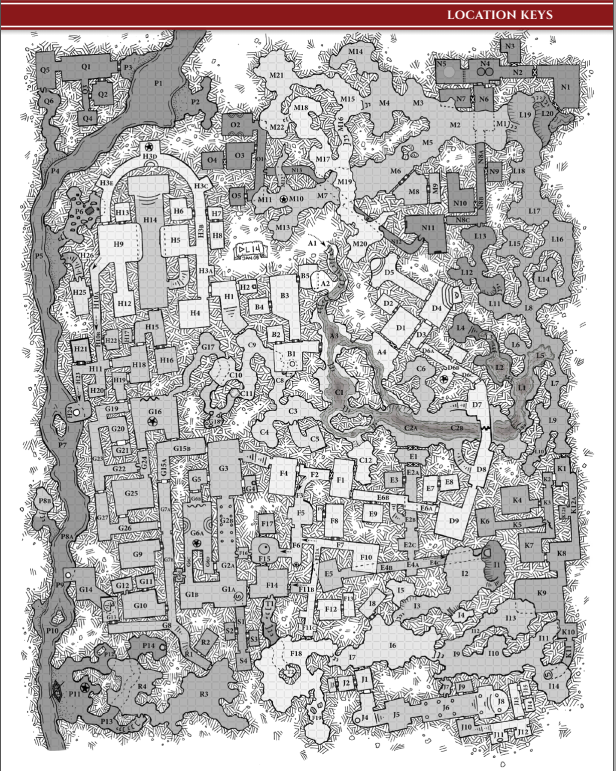
A big beauty of a dungeon complex, interwoven caverns, catacombs, sewers and tombs, each one precisely dated (in a reversal of the usual organization, the more recent tombs represent the apex of necromantic potency for the original elven inhabitants so both undead and protections tend to be stronger, and treasures more lucrative). There’s a few natural hazards like the aforementioned sewage and a river but most of the place is traversable. Secret doors, treasure vaults and even an entire hidden area exist. It also has chokepoints, areas that are difficult or time consuming to access. Most of the dungeon craftsmanship is applied.

The way I see it, there are 3 major stumbling blocks for AX2. One is a problem of format. The boxed text that is above each entry is clear, useful and an unambiguous representation of the rooms contents but there is something very dry and soul-draining about it. Despite the extensive attention being given to the construction of the dungeon in the prelude to the dungeon, the precise make-up, material and geometry of every room is mentioned in every description. The effect is one of exhaustion. I suspect a lot of this can just be established once for an entire area and deviations can be noted. Say, in the example offered above, the skeletons, which are by far the most important and immediate part of the room, are mentioned off-hand, while the bas-reliefs can easily be described en brief until the players actively investigate them. In other areas AX2 performs well. Technical writing is tagged [Monster] or [Loot] or [Trick] so the GM can determine with one eyeblink whether or not there is something in the chamber that must be taken into account. Monster statt blocks are given in the same chamber. A minor complaint is that worn treasure is not incorporated or mentioned in the statt block, again meaning that the GM has to carefully read the entire room key before running it. Orders of battle, when they occur, are mentioned in the relevant room, but given the non-linear nature of many of the maps, it is probably a good idea to just put it in the overview of the relevant dungeon section. On the plus side, total treasure is always given value and weight, a utility godsend.
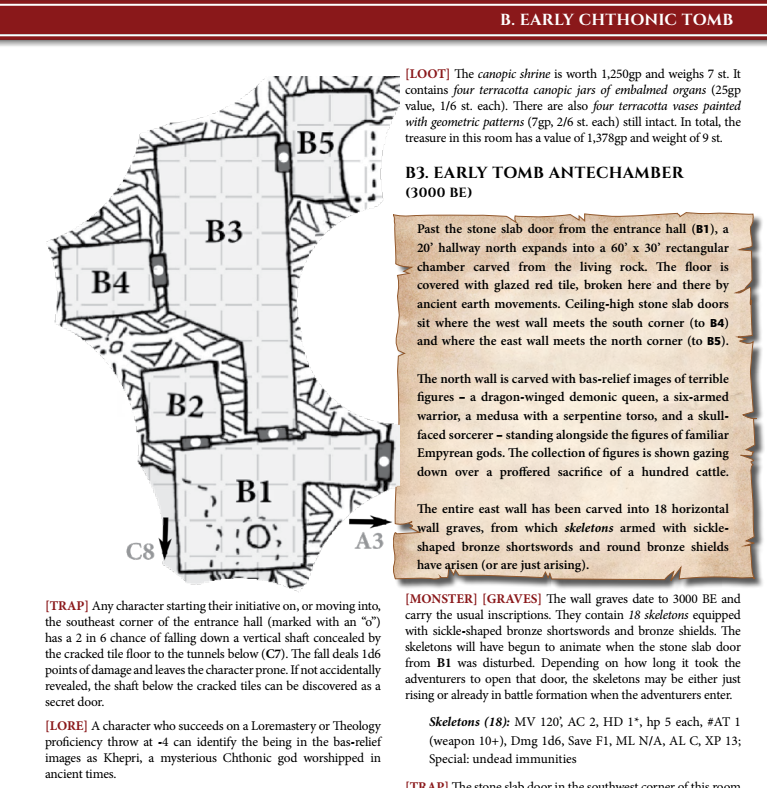
A seperate but related problem is that of the [Lore] entries. AX2 makes use of the setting’s extensive pantheon of Cthonic deities like Nargund, Telith, Bel, Naga etc. etc. and the dungeon is filled with bas-reliefs, shrines and murals dedicated to them. There’s this seperate lore entry you can roll on and then the party nerd knows the deity’s name. I think a huge opportunity was missed to sort of justify all this anthropological detail. If there had been some sort of area where knowing what particular god was being worshipped would have clued the characters in on some sort of rite to bypass its guardians, all this detail would have paid off, and the person taking the Theology proficiency would have been able to smile smugly at the morons who just got the +1 initiative proficiency. Now something vaguely like this does happen on precisely two accounts (O3 & K12B) when you can bypass the glyph of warding on a tomb if you paid attention and know the guy’s name, but this is very light and you don’t need the Theology skill.
I went back into my extensive notes: there is another great example when this theology skill could have come in useful. There is, in L20 a magical door that will only allow egress if you are wearing certain arcane vestments or bearing a royal blade. This or a knock spell will get you inside. This would have been a perfect candidate for a hint via lore spell. Hell, just putting a cryptic note in ancient Argoillian or whatever about ‘approved personel’ on the door itself would have done the job. If you are going to put in all this extra work, why not use it? Have areas that may be opened only by absorbing the setting’s intricate mythology, or guardians whose secret vulnerability can be found therein. What if you could only communicate with these mummified elders if you adopted the ancient customary forms of address of their culture from the omnipresent murals and bas-reliefs? Perhaps knowing to what deity a shrine is dedicated will allow people to call on their power, promising a dubious boon. And AX2 actually already does this, just in a way that you would never use the Theology skill; there are sacred areas that you can more easily traverse if you baptize yourself in the chaotic fonts.
If the only thing the skill does is allow you to retrieve the name of the deity, put it in parenthesis and establish beforehand that Theology is required to know the names of things. I know an argument can be made that figuring out the underlying history of the dungeon will allow characters to discern the age of the tombs corresponds to a greater or lesser level of threat but it doesn’t seem worth the bang for one’s buck.
I will mark in passing I use some of these concepts in my new high level adventure Slyth Hive and I will probably use more of them in the Sheol – Embassey of the Gods area which I will add to any extended print edition that might manifest in the future.
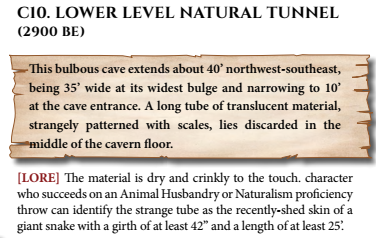
I want to give you another example. Imagine for a moment that you are playing a guy who looks like this…

and you have just entered area C10, you see the tube of translucent material with scales, and the players go: What could this be? Some sort of giant reptile. We must be wary. And then everyone is rudely interrupted by the sound of a metal dodecahedron slamming into and permanently scratching the glass gaming table and a guy who looks like this…

…goes: Acksually according to my Animal Husbandry roll this is the recently shed skin of a giant python with a girth of at least 42” and a length of at least 25″
I want you to imagine that happening.
Like the adventure itself, this review is perhaps going a bit too deep but I hope the problem is appreciated.
The third problem with AX2 is that it starts off very staid and the variety in encounters is a bit lower then you usually see with dungeons of this size. There is a lot of repetition. You get to a tomb, there’s a mummy inside. Like clockwork. Now the individual mummies are all totally different, there’s a some sort of weird ceiling-crawling dommy-mummy with a whip, a guy with two mummified cats, there’s warriors, a king attended by his bronze statues, a hierophant, twins etc. Speaking of monsters, some of the mummies are fortified with up to a dozen Sarcophagal Worms, which are the animated intenstines of the mummy, which leap forth and have seperate attacks. NICE.
But that’s all the tombs. Repetition is common. Bas-reliefs hide secret doors. Another x amount of alcoves filled with incidental treasure. Even when it does use a trick (by say, having all 128 skeletons in the tombs begin animating), it relies on the same trick multiple times. On the one hand, fair enough, it is a good trick. On the other hand, something like, say, Barrowmaze or smaller tombs like the Fight On! Gabor Lux cover similar material but are more willing to stir things up and vary their routines. Some sort of faction play or ancient rivalry with the mummies (which, I am again aware, is theoretically possible with the random table) would have been an interesting way to stir things up. What of, say, an area where two elven warlords and their undead retainers have been fighting it out for decades, their soldiers re-animating at the end of the day?
The troglodyte shaman is willing to talk with the party and mention the weird teleporting rock. The white ape elder is willing to talk to the party and mention the weird teleporting rock. The teleporting rock just takes you outside to some forest area you don’t know anything about so it makes you wonder what the hassle was all about. Even when it does something interesting, like introduce the idea of shrines and baptismal fonts that you can use to bypass the many cursed undead guardians there, it re-uses these tricks. It’s not the worst thing in the world because DnD is also a game about settling into a satisfying routine but for my tastes it needs to be shaken up a bit more, it feels just a tad too conservative.
Don’t get me wrong. Most people understand that dungeon design is not making 300+ dissonant, disconnected unique encounters worth of flavor text and fucking those in a map is not how to do these things. Repetition occurs, patterns exist. But there is a balance here between the serial and the distinct and I think AX2 can err too much on the level of some grand (and by its nature repetitive) structure.
It is not that Macris (or for that matter, Grant, I do not know how much each contributed to this particular piece) doesn’t know how to do it. There’s a terrific section in the river where you can steal the treasure of some sort of cthonic nautical deity and suffer a terrible squidification curse, there’s a large gemstone clearly visible in a black room that glistens ominously, there’s fucking super science weaponry to be found (!), a gigantic area with energy crystals set in a ceiling constallations, flanked by all manner of the living dead, spelling out the Time of Awakening, hell there’s a whole alchemy lab where you can blend monsters together or open strange gateways to other places. But it is easy to overlook because you are initially bombarded with a deluge of mundane material. One of those ‘plays better then it reads’ suspects if ever there was one.
Traps are better then the last time. Macris still doesn’t seem to like them that much, meaning there are surprisingly few traps and curses in the Tombs proper, but he does occasionally throw a mean right hook. F17 has a glas cylinder holding some sort of techno-artifact but the cylinder is also filled with ODOURLESS COLOURLESS POISON GAS. There’s a very clever trap involving falling blocks in a hallway paved with symbols of the Auran sun god, with triggers near the edge (so clerics trying to avoid stepping on them, and this concept is made explicit in the description), will set them off, this near a heavily stocked treasure chamber). I still think there is more disruption possible, from equipment destruction, to teleportation, to monster closets (actually these are applied, there are stasis fields with two nightmarish chimeras in the Alchemy lab! Yes!), to disorientation, but we have evolved beyond poison needles only.
For all the lack of major factions, enemy variety is allright, a tasteful, if disgusting blend of cave-critters, oozes, moulds, giant white apes, troglodytes, tricked out mummies (some with their own custom classes described later in the supplement), undead, animated statues and a secret chtonic elder race monster hidden in a secret area of the dungeon. Monsters have tactics, will occasionally have an order of battle, attack from ambush, are sometimes more powerful then the party is likely to be able to handle and so on. There is enough here to keep you on your toes. My personal favorite of the new monsters would be the Hydropion, a nightmarish crossbreed of schorpion and hydra. With the amount of lethal poison in the adventure and the assumed level range, it is recommended you bribe the GM into making available a custom built Dwarven Runepriest with 3 healing proficiencies and stock up on maximum Birthwort, or alternatively, just take many retainers lol.
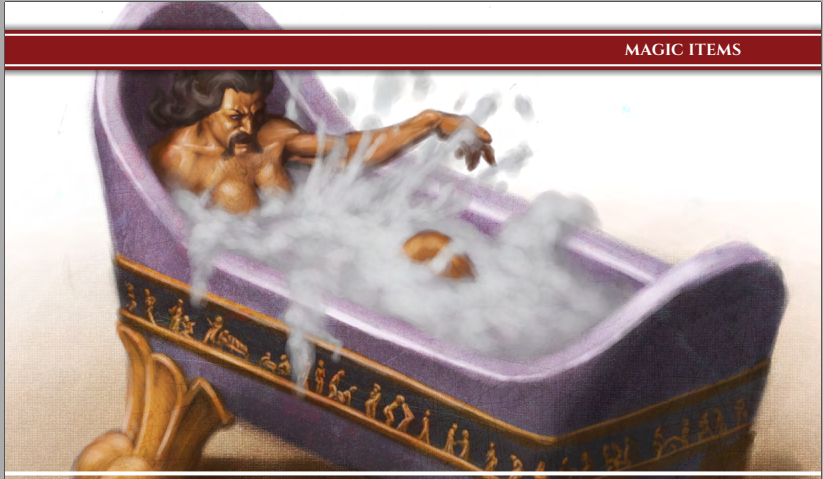
Treasure is, I suspect, excellently calibrated for adventurers of the stated level and is generous without spoiling the players. An infinite profusion of canopic jars, ceremonial paraphernalia, religious tracts, crowns, blades and bricabrac awaits, all of it conveniently labelled by weight. Having the ability to carry off and sell even the exotic hardwood chests is peak ACKS, but the opportunity to obtain an echanted treasure barge, or plunder various secret vaults is greatly appreciated. It is not quite at Gygaxian asshole levels of treasure concealment but it does its job of punishing the rash, while being at times too lenient on the pixelbitchers and floor-tile collectors, but then again, we are playing fucking ACKs. There are also plentiful new magic items, a horn that allows the summoning of a roc, cursed iron masks of great power, soul gems, elemental rods, potions, oils, enchanted blades, spellbooks, and technological items, including a fucking lightsaber!.
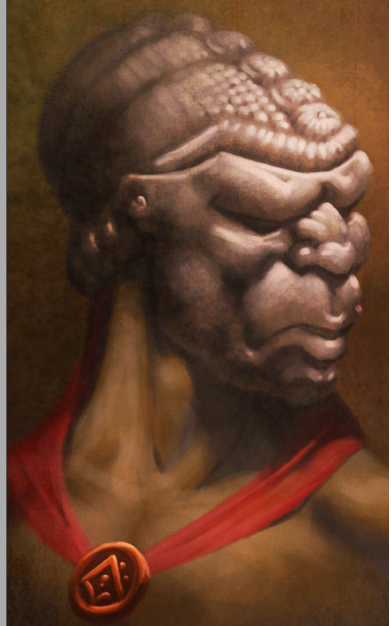
There is an extensive appendix with custom spells for priests of each gods, new classes, a listing of deities, Barbarian conquerors of Kanahu conversion notes etc. etc. About 100 out of 186 pages are devoted to the description of about as many rooms. Chunky, but this is ACKs.
The undisputed master of tombs is still Gabor Lux. The more accessible long-form tomb is still Barrowmaze. People looking for a tomb complex with a bit more depth, coherence and gravitas to it then Maze and a sense of history and its own underlying mythology, and that are willing (and able) to punch through the boxed text and grapple with the underlying contents are going to end up with something that is fit for purpose, perfectly suitable for an extended campaign, and with a few exciting set pieces (take, say, the animated statue in the Great Temple of Awakening) and nasty right hooks to reward clever play and keep people on their toes. If some of the fat could be trimmed, it would harness the power of its own elaborate worldbuilding and the text was a bit sexier, I think it could be singular. As is, it is merely good.
***
The ACKs II Kickstarter still has another 12 days to go.
Victoribus Gloria
Addendum:

My review has caused quite the stir among the ACKsist discord server. To which I say, to echo a wise-man, fair enough. If I consider something is my best work, and you rate it 3 out of 5, those are fighting words. I thought it would be worthwhile to provide additional context for my decision.
Different viewpoints (Gaming vs Simulationism).
The first criticism is valid in that I approach adventure writing in the OSR from what is or used to be the dominant view in old-school gaming: that adventures are created to be scenarios for games first and that realism or versimilitude is an important but subservient component in the achievement of that objective. My ideal level of versimilitude is something like Perlammo Salt Mines [1], areas that have enough detail so that engaging with them can be tackled in a variety of ways and details can be inferred by clever and knowledgeable players. Information is rife and relevant so reconnaissance and paying attention to detail pays off in the structure of the game. Surrounding this is a shell of mundane detail, which does facilitate a bit of immersion, serves as a buffer so that not every item is Checkhov’s Gun, and facilitates emergent gameplay since it is not possible for the game designer to anticipate every weird plan the players might come up with.
ACKs comes from a different viewpoint and seems, and forgive me if I misrepresent this, to consider the act of simulation to have a deep noetic significance in and of itself, and justifies this far greater granularity from a game-play standpoint by the assumption that this detail will pay itself back by being used in play. Merely adding the detail creates additional ‘paths‘ the players might decide to walk. If the players know it is there, they will thus attempt to manipulate it. This design philosophy also dictates that it is not neccessary to stipulate any particular gameplay purpose before including many of these details. There is a confidence, a belief, that it will pay itself back, and if not, the immersion that it generates is considered worthwhile in and of itself. This is not too dissimilar to how VtM considers roleplaying to be inherently worthy, a reward in and of itself, a ding an sich.
This is the source of much friction because some elements, say, the careful attention to detail and historicity, the way the inward burrowing nature of the map would mirror the natural excavation over the centuries, the construction of an elaborate timeline, the attention given to building materials, architecture or other details, these are evaluated as inherently meaningful in the one school and appreciated for the (visibly) great amount of effort and attention to detail which facilitates immersion whereas in the other school they are warily accepted as adornment and if they are considerably long the question becomes one of economy, where, or rather, how big is the payoff for all that work you put in?
There might be an additional difference because GM X might be able to glean some much greater effect from it then GM Y and only over time. There is something admittedly appealing about the idea that you explore a world or location where such details genuinely do matter and have been given consideration, that there are synergies and patterns hiding in innocuous things. You are encouraged to engage with the world at a higher resolution. The effect if realized would be singular but I estimate the number of people that could consistently maintain a game of such intensity would be a minority, requiring both buy in from the players and considerable effort and uncommon ability from the DM.
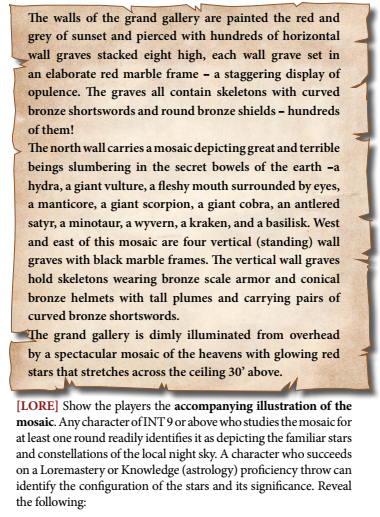
I think this difference of approach manifests itself strongly in the progression of AX2. As the characters delve deeper into the catacombs, coming closer to the time of their demise, they glean hints of the progressive corruption and degeneration of the ancient Argolleans and can, if observant, discover both the reason for their corruption and the terrible doom of their return that will befall the world of man in mere years. But this is subtle, saying much about the world, and found only through the study of an ancient constellation and an ancient astrological chart (and you had better hope you have that Astrology proficiency). A more gamist-related approach would have the doom be immanent, or trigger immediately. Here it is a terrifying Revelation, beyond the immediate solution of the PCs, and meant to spur them on to domain level escapades. The Teacher, a bug-faced entity of an Elder Race that introduced both advanced technology and the worship of terrible Cthonic Gods to ancient elves, represents a last tangible confrontation with the nightmare past, but this too is concealed, easily missed by the greedy. A comparison with DCO, can perhaps be made, but in one case, the revelation is disjointed, taking place in giant leaps, where in the other it is one that unfolds gradually and subtly.
However. This is a B/X derived system. It is, despite blackguardery from some ne’erdowells in the Reddit moderation team and a member of the lycanthrope family of the clade rattus rattus whose name rhymes with Ochai Yal, in the OSR, and since there is not a giant red sticker on the cover that states OSR Smoothbrains Be Gone This Be Simulationist Countrye, I feel assessing it by those standards is justified. The same goes for Artpunk.
Description
By my standard, good descriptions of room keys should have the following attributes:
* It should be clear in its description of the relevant elements, and the relevant elements should be easy to parse while running the adventure
* Significant permutations that come up during the game should be anticipated
* It should be evocative. The purpose of the text is to convey not just information but to give the DM something to riff off of and communicate it in his own style and voice. This should apply to set-pieces more then to connective tissue. A storeroom does not need to be particularly exciting.
* It should achieve this goal with high efficiency
A significant permutation should be read as a way in which characters interact with the key with a method of adjudication that is not obvious and a high impact on the game. Say you describe an unknown magic effect, a tunnel is sealed off by an electrified wall of water. What happens if the characters cast, say, destroy water on that wall? Since trying to foresee every possible outcome would extend the key to brobdignagian length, these sorts of extra permutations should be assessed mentally based on a x b x c, where a is the likelihood of the event occurring, b is how difficult it would be for the GM to estimate what would happen and c is the likely effect on the game. This is why I baulk at Dungeon mag style plot doors in adventures for levels 1-3 that can only be opened by a magic key or a Wish. The chance of you having access to a wish is A) not high, B) the likelihood of the poor PCs wasting that Wish on getting a plot door open is low and C) who CARES. THE DOOR OPENS.
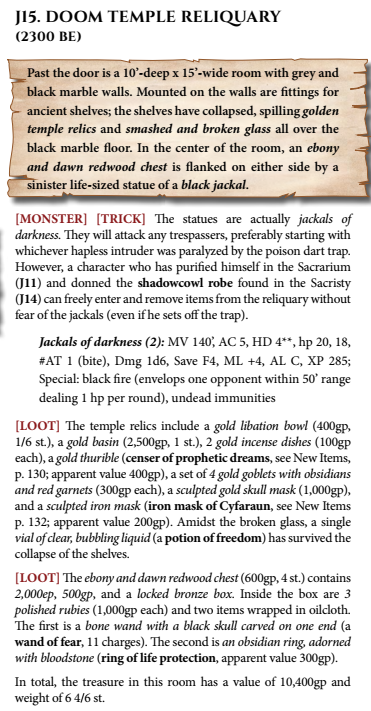
My problem with simulationism and the AX series is that we have different interpretations of a and c, and moreover, it is not clear that b is even shared as a desirable category at all. Macris writes from a viewpoint of comprehensive coverage, like an engineer. The notion that blanks can be left open or context must be inferred (as in B2) is treated as a deficiency. This causes much wailing and gnashing of teeth as I run the descriptive text through my dutch reviewer CPU used to leaner models, which seeks for critical details with a high (a * b * c), and will generate or infer the rest of the framework itself. This coupled with an already very fine grain and high density (notice how, in the above example, the chests also have weight and may be carried off, or the described unique art objects, or the unique treasure objects) makes absorbing the entire work labor intensive, and in this case, running it on the fly after only skimming it would be wasteful.
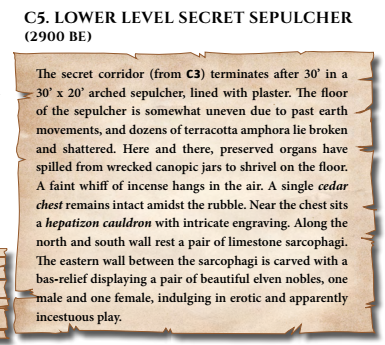
The result is very precise, very comprehensive room descriptions that encompass every feature. The position, shape and composition of nearly every object is described. For manual mapping purposes this is great but taken as a whole the effect is almost exhaustive. I am reminded of Demon Bone Sarcophagus.
Structure vs Variety.
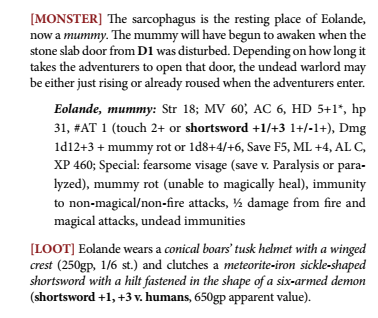
I am overall quite positive about the encounters in AX2, I suspect they would be enjoyable, and there is good variety here, by which I mean not simply cosmetic variety (which I appreciate, but assign secondary importance to), but variety in terms of how the enemies would be tackled. The gemstone protected by the Black Pudding, the surprising animation of a numerous host of skeletons, the grand order of battle in the Room of the King, these are present to disrupt players from their dungeon-crawling routine. But the dungeoncrawling routine is itself is the main course. It might be interesting to make a one-off that consists of nothing but exceptions, but to build an entire megadungeon on nothing but exceptions is ultimately foolishness. Structure falls away, there is virtually no way to anticipate threats, and only arbitrary contrived reason to stitch the whole together, triggering regression to a more passive mode.
The critique is that my preference for a more varied model, which is to say, a break from routine, is ultimately poisonous. The example of Shadowrun RPG is used. In Shadowrun, a certain adventure introduced a plot twist where the party is betrayed by their employer. Soon, the employer turning on the party became a trope, completely defeating its original purpose. You would see a similar effect in first person shooters after Half-life introduced the same concept.
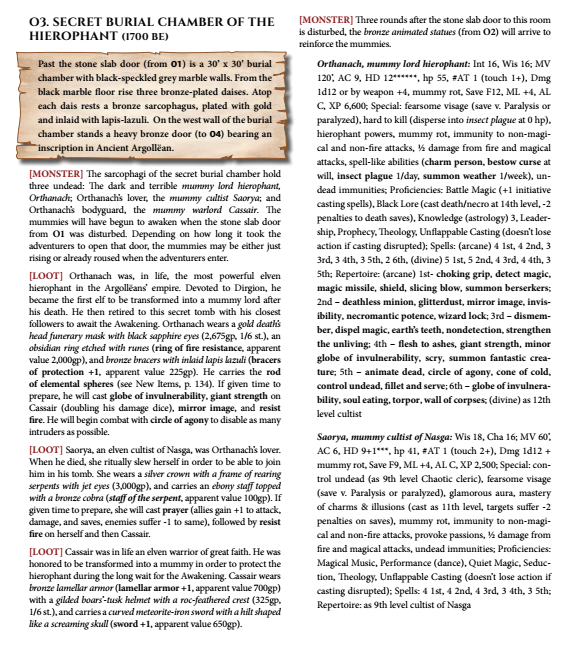
Here I think it might be useful to think of variety in terms of Gambits and Clades. In chess, a gambit is the name of a maneuver that ostensibly sacrifices material for positional advantage. This gambit loses much of its effectiveness if the opponent knows what is coming. In D&D terms, a gambit would be something that can work once (say having the party get captured and stripping them of their equipment), but would be tiresome, irritating or even damaging to the game as a whole if it became part of a routine. A lot of railroading, quantum ogres and other narrative techniques are ultimately gambits. This is not to say such conceits should be avoided entirely. Surprise and novelty represent welcome breaks but to hinge the entire adventure (or for that matter, a campaign) on such trickery is the domain of magicians, not module cobblers. Craftsmanship is what is ultimately needed, because ultimately people show up to play D&D, not a subversion of D&D. In this we agree.
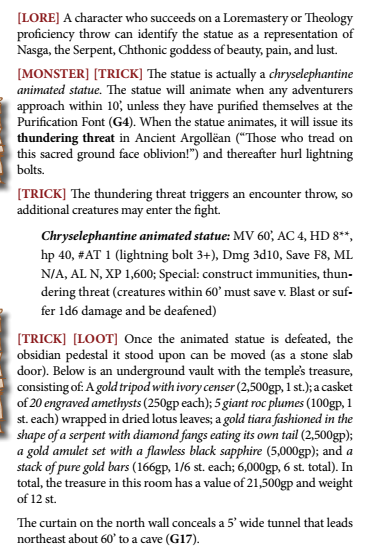
In Biology, a Clade is a group of organisms derived from a common ancestor. In D&D terms, a clade should be conceived of as a type of encounter that can have a vast amount of permutations but share a common set of characteristics or mechanical hardpoints that determine how they are interacted with. Traps, monsters, doors, treasure, weirdness and even something more specific like ‘monsters attacking from surprise’ would be examples. An orcish prisoner or a wandering thief can have totally different attributes, but in the end they are both potential henchmen (in this example, a doppleganger posing as a prisoner would be one clade posing as another clade).
It is self-evident that AX2 has a great deal of variety within, say, the monster type (introducing many new creatures and customized mummies alone). In terms of Clade variety, however, I would describe it as more narrow then some of its heavy and superheavy cousins, though within acceptable parameters (hence the rating of good). Prisoners to rescue, riddles to solve, rival adventuring parties exploring the dungeon, monstrous factions to manipulate, illusions to beguile and ensnare. These are comparatively rare in AX2. The weight of most social interactions, with the exception of the troglodyte and ape tribes, is placed on the following table for mummies, and their default is to prepare for battle. I am unsure how much this table ‘covers’ and how likely it would be that the adventurers do anything but cut down the abominations whose tombs they rob.
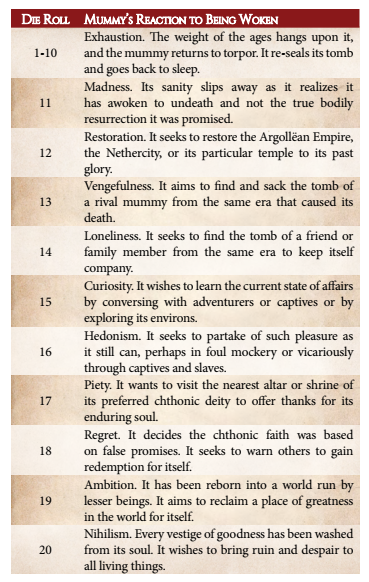
I believe this is fun, and it is clearly the product of an immense amount of effort. But I do believe that a greater dynamism would increase, rather then decrease its potency, and this has factored into my rating.
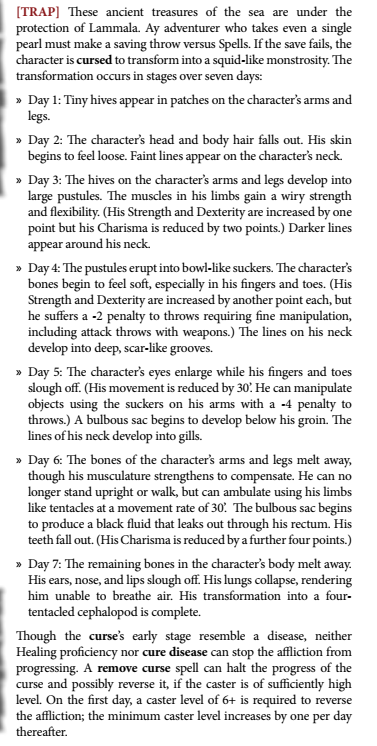
So! I thought it would be interesting to look at trap/monster/environmental hazard/special frequency between the first 100 rooms of Secrets of the Nethercity and Barrowmaze to see if my initial hunch was correct. Areas with multiple sub-areas were compressed into a single entry. A room with both a trap and a monster would count for both traps and monsters. Multiple monster encounters in a single room count as a single monster. It is quite possible this method has plentiful limitations in case of asymmetrical distribution of particularly, special encounters and rooms (which do tend to be deeper into the dungeon) but hopefully this will apply to both and I don’t have to worry about it too much. An oldschool term for custom monsters, extremely weird setpieces or other was Saturday Night Specials. Nethercity TRICKS that resemble traps are counted as Traps. I have not tallied levers that open other areas of the dungeon. I do not count mummy courtiers or warlords as special, but mummies with custom class levels are legitimate. Yellow mold is ambiguous so I have counted it as monsters in all cases.
Barrowmaze
Random encounter frequency: 1 in 6/2 turns
Monsters: 54
Traps: 12 + 17 pits (est.)
Weird: 9
Specials: 3 (kelmok the necromancer leading skeletons, the Fount of Law, Vermingtrix the Reaver)
Environment: 2 (stink rooms)
Nethercity
Random encounter frequency: 1 in 6/3 turns
Monsters: 31 (39)
Traps: 9
Weird: 5
Specials: 10 (mummified transmogrifier w. baboon viper, mummy nightblade, undead insect swarm, mummified spellsword, mummy cultist of iskara, mummy enchantress, mummy cultist of nasga, mummy w. cats). Grand Cthonic Reliquary. Great Temple Grand Gallery.
Environment: 3 (effluvia from sewage)
Stonehell (traps only triangulation) – 1st 100 rooms starting from level 1A-1C
Traps: 16
The point is to visualize, or in some way provide insight into, the flow of the dungeon.
Review Standards, Effective rating and ‘Bouncing off’
As explained in my Review Standards, a 3 star rating is my most ambiguous rating, representing everything from something that is barely acceptable to something that is good. Below a *** I do not consider it worth the effort of running. I consider AX2 to be firmly in the good category. The reason it is not rated higher is that its density and format translate into X amount of effort and required to get and an estimated Y amount of dungeon-crawling entertainment, and I think there are other models that deliver an equivalent Y with less payoff X. You might get more Y, you might have to pay less X, and the equation alters.
A student of phrenology by the name of S1AL mentioned that I might have ‘bounced off’ AX2 upon my sojourn and I think that is a fair description, in the sense that my initial foray did not penetrate or cut through the obstacles of its implementation and I was (and am) not fully convinced of its strengths.
Fight On gentlemen.

WRT the anal repetition of exact room dimensions, features etc – as I understand it, there are a bunch of people out there who still do full-on graph paper mapping in play. I assume the immense detailed description of the room’s structure is for them.
LikeLike
I map using a VTT, and before that I did use exact measurements and I even advocate for them. It is structure, but it is structure that is also on the map. It is more of a combination of factors that causes these dementor room descriptions, not any particular factor on its own.
LikeLike
But you could read the dimensions off the map. Why put them in the text?
LikeLike
nice
LikeLike
Cool map.
LikeLike
The map is exquisite
LikeLike
Does your mom have an Animal Husbandry or Naturalism proficiency? Because she can accurately assess the girth of my giant snake.
LikeLike
[OT – Tolkien Editions]
I am gathering recommendations for attractive well made hardback editions of Lord of the Rings and The Hobbit prior to a sweep through his work. I like the recent Tolkien illustrated Silmarillion though I’m not sure if I prefer that to the original 1977 edition for reading.
What is your current favourite edition?
LikeLike
I’ve got only softcovers, and those uneven, sadly. I think the covers alone would fill you with disgust.
LikeLike
I read this paperback edition in my teens till pages fell out,
https://www.mytolkienbooks.com/books-by-tolkien/middle-earth-related/lord-of-the-rings/complete-sets/the-lord-of-the-rings-unwin-books-1984/
Reading the same edition has its advantages, it may help with building on how you previously imagined the story, but when something has become *overfamiliar*, when you want to imagine the characters and landscapes differently *as an exercise in style* then a new edition can help with a clean start.
I have been surprised this week with just how many editions there are, a few for example,
It is a pain in the arsicle not being able to hold a book in person and turn the pages, check the print quality, does it lie flat, paper too white.
LikeLike
The review was merely good. The analysis below excellent.
While I have a soft spot for simulationist lore, I think it requires a unique setting with lore that’s worth getting into. For me, that’s Glorantha. I would appreciate for a good adventure that would introduce such rich lore to the players (and there are some).
However, I’m not sure the format of a dungeon – in which you explore the world by looking at frescos and other dead things – is a good fit for this. To get to know the lore, it’s better if you experience it by… you know… interacting with the world of the living.
This adventure sounds like an archeologist’s wet dream. I respect that. I can’t imagine having a party of players who would actually care about archeology. (And I do have an archeologist friend! Who would probably be the first to ignore this stuff.)
Reading all those descriptions, this could be awesome as a 3D videogame. Feels like the sort of meticulous detailed work that people put eg. into the Lord of the Rings films. But those are visual mediums – I could spend a lot of time enjoying the murals and marble floors etc. if I could see them. Not when I friend is reading text from a book, though.
LikeLike
It would be possible to experience it by conversing with the mummified grandees of ancient Argouille. There is a richness and a fine grain to the setting also, although the author is a great fan of classic fantasy tropes, so you are liable to find herein a great plethora of history and classic fantasy, interspersed with science fictional technology in the dawn ages. Expect tropes, detailed and varied.
Perhaps it is worth a second look.
I have ordered a printed copy shortly after adding the addendum. I suppose I shall have to become obsessed with it until I can either dismiss it out of my mind or I have solved it.
LikeLike